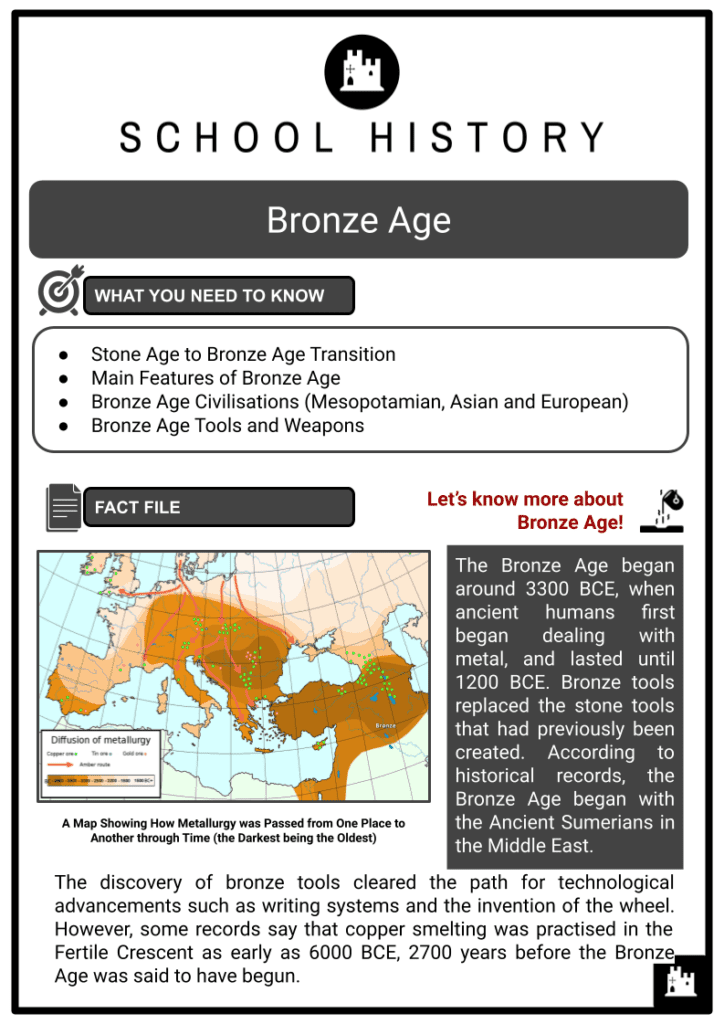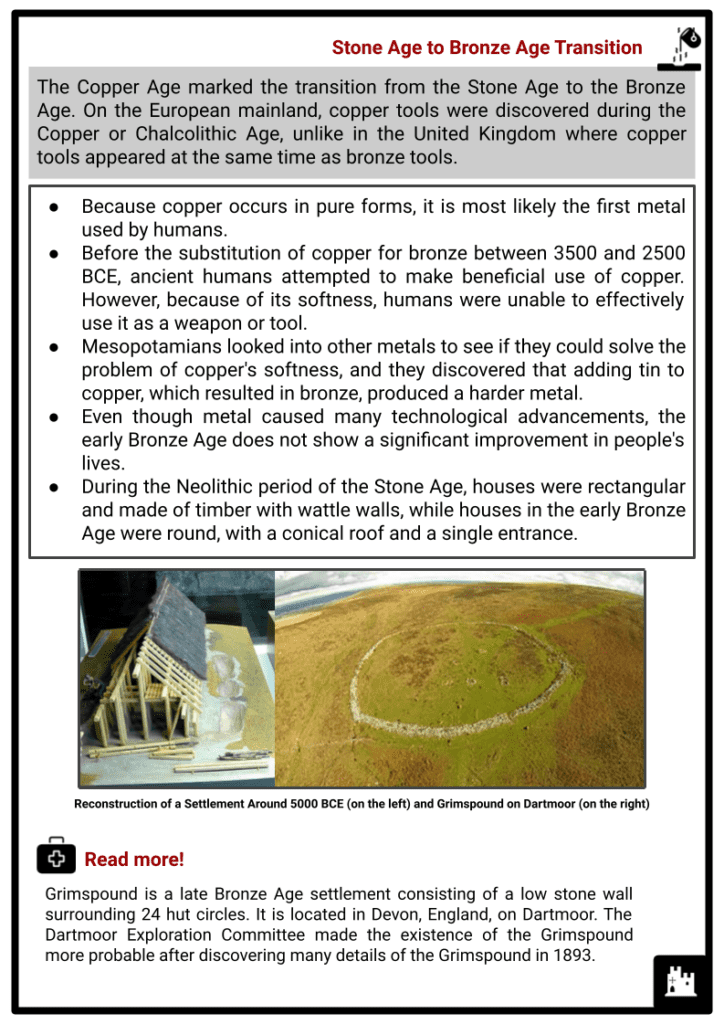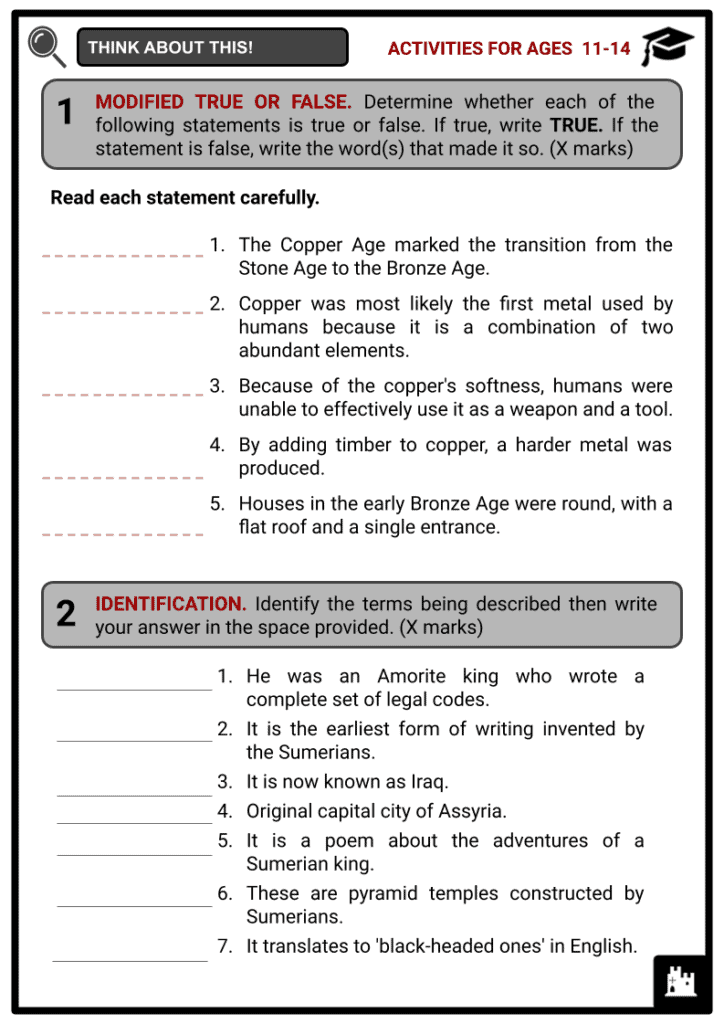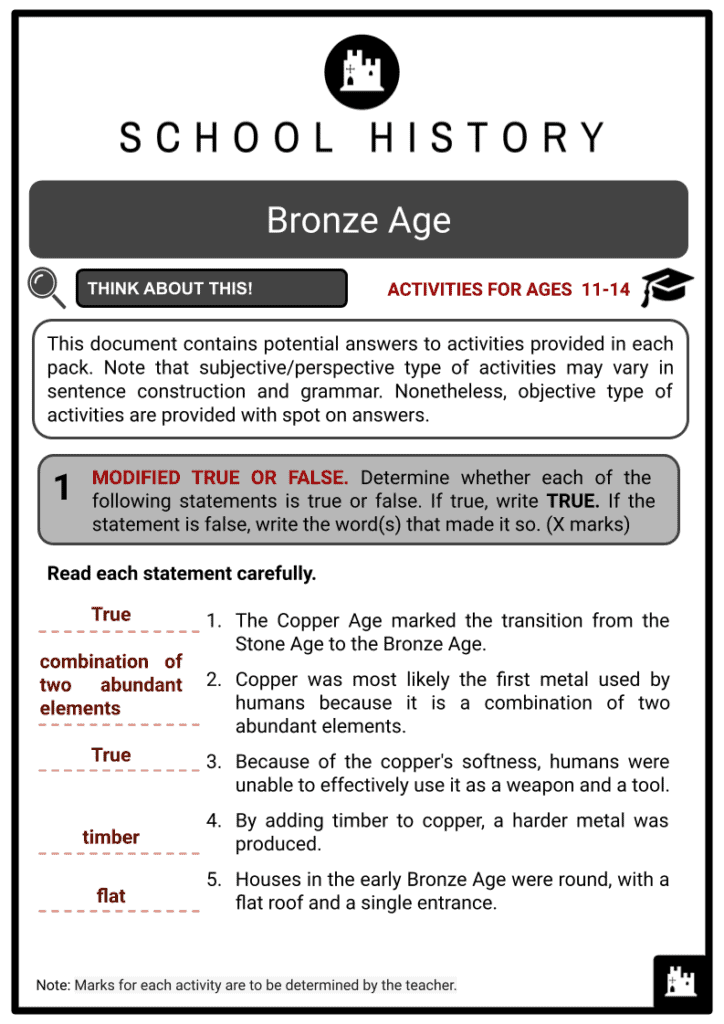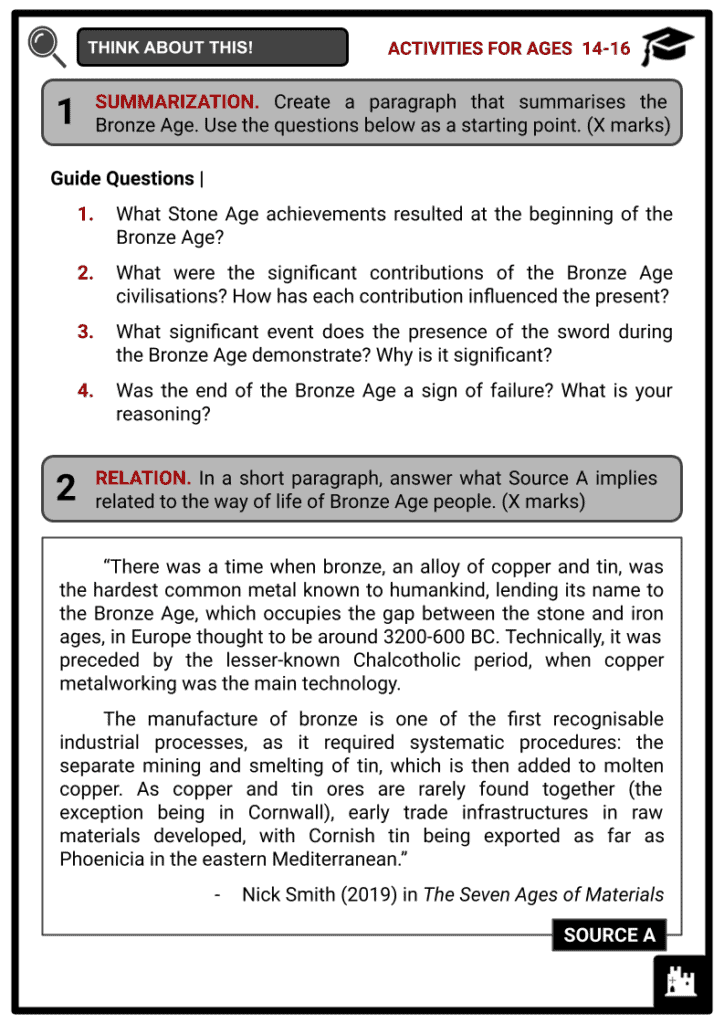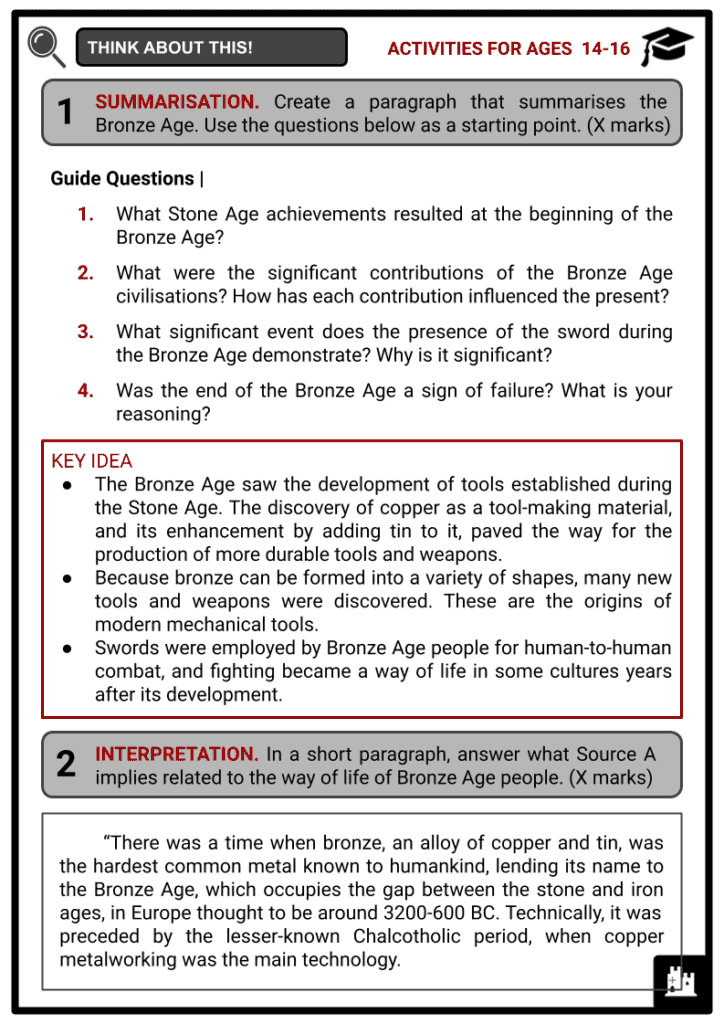Bronze Age Worksheets
Do you want to save dozens of hours in time? Get your evenings and weekends back? Be able to teach about the Bronze Age to your students?
Our worksheet bundle includes a fact file and printable worksheets and student activities. Perfect for both the classroom and homeschooling!
Table of Contents
Add a header to begin generating the table of contents
Summary
- Stone Age to Bronze Age Transition
- Main Features of Bronze Age
- Bronze Age Civilisations (Mesopotamian, Asian and European)
- Bronze Age Tools and Weapons
Key Facts And Information
Let’s find out more about the Bronze Age!
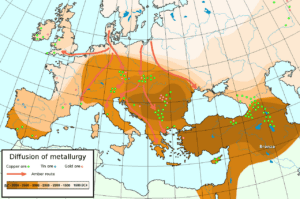
- The Bronze Age began around 3300 BC, when ancient humans first began dealing with metal, and lasted until 1200 BC. Bronze tools replaced the stone tools that had previously been created. According to historical records, the Bronze Age began with the Ancient Sumerians in the Middle East.
- The discovery of bronze tools cleared the path for technological advancements such as writing systems and the invention of the wheel. However, some records say that copper smelting was practised in the Fertile Crescent as early as 6000 BC, 2700 years before the Bronze Age was said to have begun.
Stone Age to Bronze Age Transition
- The Copper Age marked the transition from the Stone Age to the Bronze Age. On the European mainland, copper tools were discovered during the Copper or Chalcolithic Age, unlike in the United Kingdom where copper tools appeared at the same time as bronze tools.
- Because copper occurs in pure forms, it is most likely the first metal used by humans.
- Before the substitution of copper for bronze between 3500 and 2500 BC, ancient humans attempted to make beneficial use of copper. However, because of its softness, humans were unable to effectively use it as a weapon or tool.
- Mesopotamians looked into other metals to see if they could solve the problem of copper's softness, and they discovered that adding tin to copper, which resulted in bronze, produced a harder metal.
- Even though metal caused many technological advancements, the early Bronze Age does not show a significant improvement in people's lives.
- During the Neolithic period of the Stone Age, houses were rectangular and made of timber with wattle walls, while houses in the early Bronze Age were round, with a conical roof and a single entrance.
- Grimspound is a late Bronze Age settlement consisting of a low stone wall surrounding 24 hut circles. It is located in Devon, England, on Dartmoor. The Dartmoor Exploration Committee made the existence of the Grimspound more probable after discovering many details of the Grimspound in 1893.
Main Features of the Bronze Age
- Several prominent Bronze Age civilisations from various continents will be discussed in the following sections of the resource. Meanwhile, here's a quick rundown of some of the Bronze Age's highlights.
Metallurgy
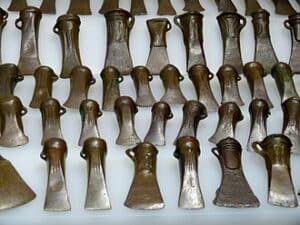
- The most significant development in the Bronze Age was the evolution of metallurgy, particularly the discovery of bronze.
- Smelting is the process of heating mined metal ores in a fire or blast furnace.
- The first evidence of metallurgy is found in Serbian sites dating from the 5th and 6th millennia BC.
- Huge numbers of bronze artefacts have been discovered in many parts of the world, implying that bronze was also used as a measure of wealth and a determinant of social status.
- Vast numbers of bronze tools, typically socketed axes with little to no wear, have also been discovered in Europe. Take note that axes were the most valuable tools at the time.
Arts
- The arts of the Bronze Age linked the Stone Age to the Iron Age and reflected the environment of the time.
- In addition to bronze tools and weapons, ornamental and decorative designs on helmets, body armours, shields and weapons became popular.
- Bronze casting techniques were also used to create sculptures.
- The best examples of Bronze Age art were discovered around the Mediterranean civilisation during the rise of Mesopotamia.
- This includes painted ceramics, fresco murals, landscapes and figurative paintings of humans and animals.
- Religious relief and free-standing sculptures were carved from stone and wood.
- Numerous artistic tributes to kings and other rulers were also discovered.
- The most valuable Bronze Age statue was the Palaikastro Kouros. It was a chryselephantine sculpture carved from a hippopotamus tooth discovered on the Greek island of Crete.
- During the Bronze Age, the arts began to reflect the community that created them, as well as their rulers and religious practices.
Trade
- Trade and industry were central to the development of Bronze Age civilisations.
- Some Indus Valley artefacts were discovered in ancient Mesopotamia and Egypt. This is clear evidence that the civilisations mentioned were trading with one another.
- During ancient times, long-distance trading was restricted to luxury goods such as spices, textiles and precious metals.
Mesopotamian Civilisation
- Various civilisations entered the Bronze Age at different times. Sumer, Babylonia and Assyria were three remarkable ancient civilisations that emerged during the Bronze Age.
Sumeria
- Throughout ancient Mesopotamia, Sumerians began to establish civilisation. By 4000 BC, a dozen cities had been established, including Eridu and Uruk, in modern-day southern Iraq.
- They chose the name Sag-giga, which translates to 'black-headed ones' in English, to reflect their appearance.
- Not only were the Sumerians among the first civilisations, but they also pioneered the use of bronze and irrigation canals.
- Cuneiform, invented by the Sumerians, is one of the earliest forms of writing. They also constructed ziggurats or pyramid temples.
- During ancient times, the Sumerians had literature as well. The Epic of Gilgamesh, a 3000 line poem about the adventures of a Sumerian king, is the most well known.
Babylonia
- Babylonia, which is now known as Iraq, was founded around 1900 BC. The Amorites were the first people to settle in Babylon, the Babylonian capital.
- The Code of Hammurabi was written by Hammurabi, an Amorite king, and aided Babylon to become the most powerful city in the region, surpassing Ur, Sumeria's capital city.
Assyria
- Assyria dominated other ancient Mesopotamian civilisations in terms of political and military power.
- Its empire included modern-day Iraq, Turkey and Egypt, as well as territories between the three countries.
- The Assyrians rose to power by constantly fighting the pharaohs of Ancient Egypt and the Hittite Empire of Turkey.
- Assur, its original capital, was located on the west bank of the Tigris River.
Asian Civilization
- From roughly 3300 to 1200 BC, areas of Asia experienced the Bronze Age at the same time as the Middle East. The Asian Bronze Age collapsed almost at the same time as other major Bronze Age civilisations.
China
- The Majiayao culture claimed ownership of the bronze objects discovered in China. These were made between 3100 and 2700 BC.
- Because the corresponding periods occurred at the same time, the Early Bronze Age was referred to as the 'Shang Dynasty' period (1600 to 1100 BC), while the Later Bronze Age was referred to as the 'Zhou Dynasty' period (1100 to 300 BC).
- Around 1600 BC, the Shang or Yin dynasty rose to power. The majority of bronze artefacts were made from oracle bones, such as turtle shells and cattle scapulae.
- Erlitou manufacture in Henan constituted the earliest metallurgy industry. Erlitou was the first large-scale bronze industry discovered in China, employing the new-fangled section-mould technology to create ritual containers and other bronzes.
- Recently, many unusual spearheads with downward hooks and small loops have been unearthed. These were interpreted as proof of the metalworking tradition's influence on China.
Korea
- In Korea, the Bronze Age began between 1000 and 800 BC. The Korean Bronze Age featured distinct typologies and styles, particularly in ceremonial artefacts.
- The Mumun pottery period, when vessels were manufactured for storage and cooking, supplied a substantial portion of the pottery assemblage. In the middle of the Mumun pottery period, southern Korea began bronze manufacture.
- The bronze daggers conferred prestige and authority on those who used them and were buried with them in high-status megalithic tombs at south-coastal sites like Igeum-dong.
Japan

- Around 300 BC, Japan recognised the use of bronze at the start of their Early Yayoi period. As a result, arriving settlers introduced metalworking and agricultural practices.
- Other East Asian ancient civilisations, such as China and Korea, influenced Japan's bronze smelting techniques through trade and immigration.
Indus Valley
- Around 3300 BC, the Indus Valley civilisation began the Bronze Age in the Indian subcontinent.
- The Harappans were the people who lived in the Indus Valley. They invented metallurgy techniques and produced copper, bronze, lead and tin.
- The Harappan culture, which existed between 1900 and 1400 BC, witnessed the transition from the Bronze Age to the Iron Age.
- Mehrgarh was said to have produced a 6000-year-old copper amulet.
- Cities in the ancient Indus Valley civilisation were notable for their urban design. The houses were constructed of baked bricks. The drainage and water supply systems that ran through the cities were elaborate. Most importantly, they practised handicraft techniques such as carnelian products and seal carving, as well as metallurgy.
European Civilisation
- The graph below depicts various European civilisations that existed during the Bronze Age. Nonetheless, this resource will concentrate on the United Kingdom and Ireland.
Great Britain
- The Bronze Age in Britain began around 2100 BC and ended around 750 BC. The primary reason for the bronze's arrival in Britain was migration. Some of the artefacts were thought to have originated in modern Switzerland, with the tooth enamel isotope discovered in early Bronze Age graves near Stonehenge serving as evidence.
- The Deverel-Rimbury culture emerged during the Middle Bronze Age, between 1400 and 1100 BC. The majority of the tin used to make bronze was mined in Devon and Cornwall.
- During the early Bronze Age, dead bodies were buried in individual barrows known as tumuli on modern British Ordnance Survey maps, or in cists covered with cairns.
- Soon after the discovery of copper, Bronze Age British people began alloying the element not only to make bronze but also to make brass by adding zinc. In North Wales, a 70-metre-deep copper mine was discovered at Great Orme.
Ireland
- The Bronze Age began in Ireland around 2000 BC, when they produced Ballybeg type flat axes, which were one of the most visible pieces of evidence discovered in the country, and other related metalworks.
- Lough Ravel (2200 BC), Ballybeg (2000 BC), Killaha (2000 BC), Ballyvalley (2000-1600 BC) and Derryniggin (1600 BC) were the main types of flat axes in the Irish Bronze Age, along with various metal ingots shaped as axes.
Bronze Age Tools and Weapons
- Bronze was thought to be a better metal for tools and weapons than copper. The ancient Sumerians were the first to discover and exploit its durability. When mankind first considered employing metals for tools, they began experimenting with various metals and their qualities. Bronze, created by mixing 90% copper and 10% tin, appeared to be harder than its two constituents and far more durable than stone tools.
Spears
- At around 1800 BC, Bronze Age people cast bronze as spears, which they primarily used for hunting by stabbing and slashing because it was not as hard as iron.
Swords
- A sword is a type of weapon that was discovered between 1700 and 1600 BC, during the Bronze Age. It was a spear version in which the spearheads were enlarged to almost cover the entire length of the sword. It implies that human-to-human combats existed during the Bronze Age because archaeologists believed that damage patterns on discovered artifacts of Bronze Age swords were caused by another sword or by blade-to-blade contact.
Shields and Armour
- Bronze shields and armour were not discovered until the later Bronze Age.
Axes
- Toolmakers created Bronze Age axes by first selecting a shaft with a natural 90-degree crook.
Halberds
- These are bronze blades in the shape of a scythe. The specifics of whether the halberds were used for ceremonial
- purposes or as weapons are still being debated.

